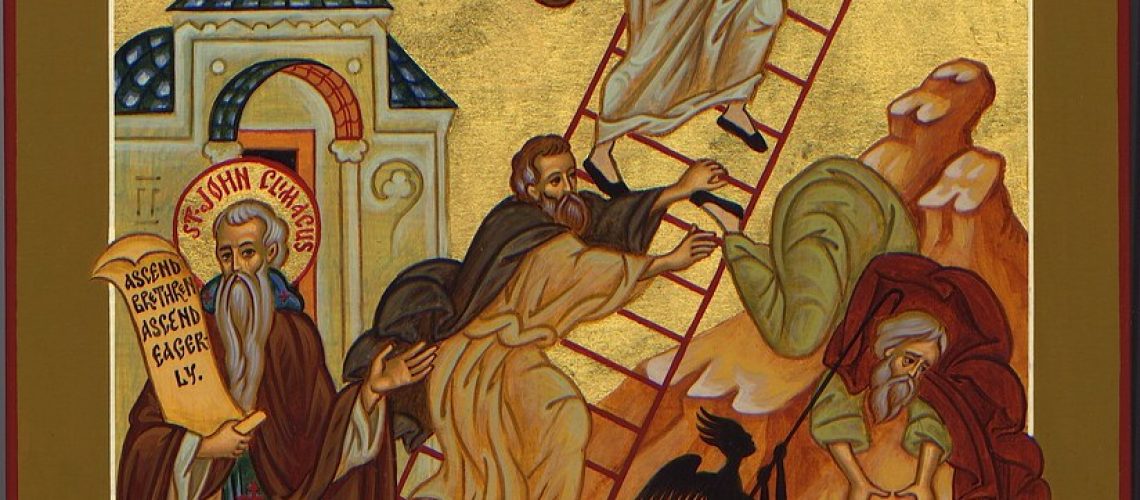Author:
John Climacus was born in AD 579. Climacus is not a part of his name. Rather it simply means ladder. This is because John is mainly known by his most famous work “The Ladder of Divine Ascent.” When he was twenty-one years old, John joined the Monastery of St. Catherine on Mount Sinai. He withdrew to live as a hermit. He
became the abbot of the monastery of St. Catherine in the year 600 AD. He remained as such until shortly before he died.
Context:
John wrote his book while he was an abbot of a monastery. The book is a guide for monastics who chose the sublime life. It navigates their way toward union with God aiding them in cultivating virtue and escaping the snares of the devil. The usage of a ladder with 30 steps as a symbol of the spiritual way toward heaven is borrowed from the Old Testament story of Jacob who saw a ladder reaching heaven in a dream. The 30 steps represent the 30 years of the life of Jesus before He began His public ministry.
Content:
- On renunciation of the world
- On detachment
- On exile or pilgrimage; concerning dreams that beginners have
- On blessed and ever-memorable obedience
- On painstaking and true repentance which constitutes the life of the holy convicts; and about the Prison
- On remembrance of death
- On joy-making mourning
- On freedom from anger and on meekness
- On remembrance of wrongs
- On slander or calumny
- On talkativeness and silence
- On lying
- On despondency
- On that clamorous mistress, the stomach
- On incorruptible purity and chastity, to which the corruptible attain by toil and sweat
- On avarice (love of money)
- On non-possessiveness (that hastens one Heavenwards)
- On insensibility, that is, deadening of the soul and the death of the mind before the death of the body
- On sleep, prayer, and psalmody with the brotherhood
- On bodily vigil and how to use it to attain spiritual vigil, and how to practice it
- On unmanly and puerile cowardice
- On the many forms of vainglory
- On mad pride and on unclean blasphemous thoughts; concerning unmentionable blasphemous thoughts
- On meekness, simplicity, and guilelessness which come not from nature but from conscious effort, and about guile
- On the destroyer of the passions, most sublime humility, which is rooted in spiritual perception
- On discernment of thoughts, passions and virtues; on expert discernment; brief summary of all aforementioned
- On holy stillness of body and soul; different aspects of stillness and how to distinguish them
- On holy and blessed prayer, the mother of virtues, and on the attitude of mind and body in prayer
- Concerning Heaven on earth, or Godlike dispassion and perfection, and the resurrection of the soul before the general resurrection
- Concerning the linking together of the supreme trinity among the virtues (faith, hope and love); a brief exhortation summarizing all that has said at length in this book
Relevance:
Many Orthodox Christians dedicate their lent reading to the Ladder of Divine Ascent. In Eastern Orthodox Lent, a week is dedicated to John Climacus and his ladder. Therefore, I chose this time to share a few words about this book. The book is heavily ascetic and is directed to monastics. However, much can be learned from it even for the lay person seeking virtue and union with God. There are difficult passages in the book. If you are used to reading ascetic discourses such as the Sayings of the Desert Fathers or the Philokalia, you should be okay. If you are not, you might want to do two things. First, grab a copy for the lay person which would recontextualize difficult texts that are only fit for seventh century ascetics to your twenty first century perspective. Second,
make sure you read it under the guidance of an experienced spiritual father who has read the book. You can never read this book and not cultivate a new perspective on the beauty of living a spiritual life.

